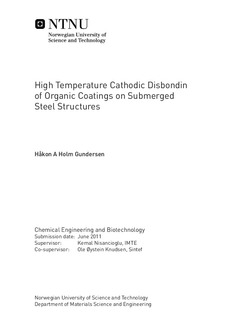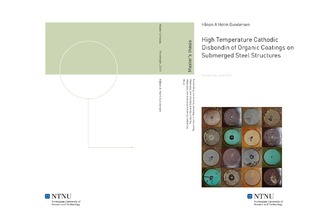| dc.contributor.advisor | Nisancioglu, Kemal | nb_NO |
| dc.contributor.advisor | Knudsen, Ole Øystein | nb_NO |
| dc.contributor.author | Gundersen, Håkon A Holm | nb_NO |
| dc.date.accessioned | 2014-12-19T13:26:01Z | |
| dc.date.available | 2014-12-19T13:26:01Z | |
| dc.date.created | 2012-04-20 | nb_NO |
| dc.date.issued | 2011 | nb_NO |
| dc.identifier | 517093 | nb_NO |
| dc.identifier | ntnudaim:6636 | nb_NO |
| dc.identifier.uri | http://hdl.handle.net/11250/248972 | |
| dc.description.abstract | There are currently no standard test methods for testing the cathodic disbonding properties of organic coatings at temperatures above 100 C. There are several subsea oil and gas reservoirs with high temperatures, some as high as 200 C. The main goal of this work was the development of a new apparatus and testing procedure for high temperature cathodic disbonding, hereby referred to as HTCD (High Temperature Cathodic Disbonding).A test method for the cathodic disbonding of organic coatings from submerged steel subjected to high temperatures was studied. The test method requires the use of a specialized HTCD apparatus. In this test method, sample plates were mounted between two channels, one containing a hot (150 C) oil flow and the other containing a pressurized, cold, salt (3.5 % NaCl) water flow. Accelerated conditions made it possible to test the cathodic disbonding properties of several coatings in four weeks. Four weeks is a typical duration for coating prequalification tests. Several commercial coating products of different generic types provided by different manufacturers were tested. The results indicate that adequate coating products for high temperature underwater exposure are available.The required cathodic protection current for the samples tested in the HTCD apparatus was continuously monitored. No correlation between the required cathodic protection current and the extent of cathodic disbonding was observed.A long term test with more field like conditions and a duration of 400 days was performed. Low levels of disbonding for most of the tested products in the 400 day test made comparison to the accelerated tests difficult.An attempt was made to determine the oxygen diffusion coefficient of five coating products. The attempt was unsuccessful. The same method had previously been used to study coatings with a thickness of up to 300 micro m, the coatings studied in this work were between 600 micro-metres and 1200 micro-metres. It remains uncertain whether the chosen method can be used for coatings this thick.Results from electrochemical impedance spectroscopy, performed in a pressurized vessel, showed a large reduction in the ionic resistance of a submerged organic coating upon heating from 30 C to 150 C. This showed that elevated temperatures throughout the coating can reduce the ionic resistance to a level where even an intact coating is incapable of protecting the substrate. Studies of coating samples at ambient temperatures after exposure to higher temperatures showed that exposure to heat causes a lasting reduction in impedance. High impedances correlated with good performance in the HTCD tests.Investigation with a scanning electron microscope (SEM) provided images where the extent of the cathodic disbonding was clearly visible. Electron-dispersive X-ray spectroscopy (EDS) enabled the identification of oxides discovered at the holiday and beneath the disbonded coating. Zinc and calcium oxides were identified at and near the holiday; iron oxide was identified beneath the disbonded coating. | nb_NO |
| dc.language | eng | nb_NO |
| dc.publisher | Institutt for materialteknologi | nb_NO |
| dc.subject | ntnudaim:6636 | no_NO |
| dc.subject | MTKJ Industriell kjemi og bioteknologi | no_NO |
| dc.subject | Materialutvikling og -bruk | no_NO |
| dc.title | High Temperature Cathodic Disbondin of Organic Coatings on Submerged Steel Structures | nb_NO |
| dc.type | Master thesis | nb_NO |
| dc.source.pagenumber | 90 | nb_NO |
| dc.contributor.department | Norges teknisk-naturvitenskapelige universitet, Fakultet for naturvitenskap og teknologi, Institutt for materialteknologi | nb_NO |

